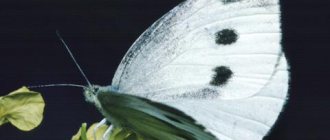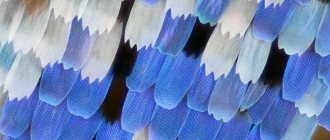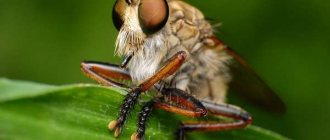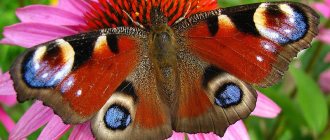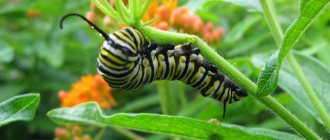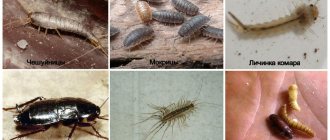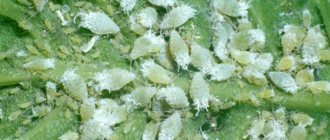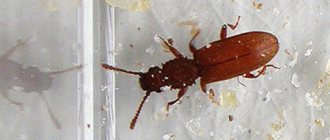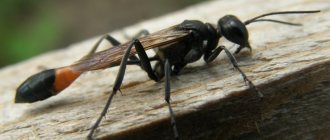About insects
In different groups of insects one can encounter wingless forms that have completely lost their wings. This also applies to those groups, the majority of whose representatives fly well: among Diptera, butterflies, Orthoptera, and bugs, forms with disappeared wings are known. In such cases, the fact of the loss of the wings that existed in the ancestors of these insects is clear.
And by examining the features of the internal structure, and comparing wingless species with a number of representatives of the same group, which have developed and reduced organs of flight, it can be established that wingless forms descended from winged ancestors.
Such loss of wings can be caused by various reasons (the transition to parasitism, to life in the soil, when living on islands or in the mountains, etc.). Even in cases where entire orders include completely wingless insects (lice, lice, fleas), the study of their structure and development in comparison with other groups of insects allows us to consider their lack of wings as a consequence of reduction and loss.
It is likely that the ancestors of fleas, for example, had wings that disappeared when the adult stage adapted to parasitism. But among the lower insects there are also orders whose representatives never had wings: the bristletail order, for example, deserves the name primary wingless. All the features of the representatives of this order give reason to consider it descended from distant wingless ancestors, who were, however, also the ancestors of winged insects.
In insects that have more or less similar front and hind wings, equipped with a dense network of veins, i.e., in more primitive ones (dragonflies, lacewings, termites, etc.), the front and hind wings move independently of each other during flight, and in In butterflies, hymenoptera, cicadas and other more highly organized forms, the front and hind wings are interlocked so that they form a single coordinated moving surface.
In flies that have only developed front wings, the hind wings are transformed into small club-shaped appendages rich in sensory hairs. They work like gyroscopes and serve as stabilizers during flight. A change in direction during flight is achieved by changing the position of the plane of the front wings (in daytime butterflies) or the amplitude and plane of vibration (in bees).
The rate of vibration of the wings of different insects varies significantly. When flying, the swallowtail butterfly makes only 5-9 wing beats per second, a bee about 200, and bell mosquitoes - 1000. This speed of contractions is ensured by sharply and densely striated muscles, which account for 15-25% of well-flying forms. body weight. The flight speed of insects is very different: for the lacewing - 0.5 m, for the bee - 3 m, for hawkmoth butterflies - 15 m per second. The strongest insects, such as hawk moths, fly hundreds of kilometers without landing. For example, there are known cases of the oleander hawk moth (Deilephila nerii), common in Mediterranean countries (where oleander grows), migrating to Leningrad and Estonia.
On the second to ninth abdominal segments, only protoriformes have single-segmented rudiments of limbs. In addition, at the end of the abdomen of lower insects there are appendages (cerci) that serve as sensory organs (this is especially pronounced in embii) or grasping organs (in earwigs). Modified rudiments of the limbs of the segments near the genital opening serve as auxiliary organs during fertilization (gonopodia). In lower groups of insects, females use their gonopodium to pick up a packet of seminal fluid—a spermatophore. The cuticle of many insects is covered with hairs of varying lengths, sometimes very densely.
Those hairs, which are simply outgrowths of the cuticle, serve mainly to create a layer of air around the body when the insect is flooded (during rain, etc.), isolating the body from contact with water. But besides them, there are many hairs and bristles on the body of insects, movably articulated with a hole in the cuticle, to the base of which nerve endings approach - these are the main tactile elements of the insect. Often the body (in silverfish) and wings (in beetles, butterflies, etc.) are covered with scales. Hairs and scales determine the color of many insects.
For example, in butterflies the bright variegated color of their wings depends not on the presence of any pigment, but on the phenomena of light resonance when light rays are refracted through the scales - the scales themselves are colorless. The metallic coloration of beetles, hymenoptera and other insects also depends on the structure of the cuticle. This coloring, which depends not on the pigment, but on the structure of the integument, is called optical. It was deciphered in 1902 by the Kyiv physicist I.I. Kosonogov. Along with optical phenomena, the color of many insects is also determined by pigments deposited by the cells of the hypodermis. Black coloration most often depends on melanin deposits. The green color common in insects (locusts, stick insects, etc.) has long been considered to be associated with plant chlorophyll, but, according to new data, it is determined by special pigments.
The coloring of many insects, especially determined by the refraction of rays in the chitinous parts of the integument, is preserved in dead dried specimens. Thus, butterflies, collected and pinned more than 200 years ago by C. Linnaeus, retain the same freshness and brightness of tones as living ones. Many beetles, such as bronze beetles, also perfectly retain their metallic luster. And the bright color of the elytra of ladybugs, orthoptera and other insects, in which it depends on organic pigments, fades and fades in collected dried specimens.
Sometimes the metallic color also fades, for example in the beetle (Cassida nobilis). Amazing variety of insect colors. Many of them can compete in color with variegated and bright flowers, and many have a dull, dull color, making them unattractive and invisible. What explains such a variety of insect colors? Coloring has enormous biological significance. Insects that are not protected by other means, if their color resembles the background on which they are kept, become invisible to the predators that exterminate them, primarily to birds.
Every insect collector knows how difficult it can be to spot a fall armyworm sitting on a darkened wooden post driven into the ground, how invisible moth butterflies are sitting on a tree trunk covered with lichens, how easy it is to pass by a green caterpillar sitting on a leaf, how a jumping caterpillar escapes from view. gray locusts on the surface of gray soil, etc. The Italian scientist Cesnola did such experiments. He collected large mantises that were grayish or green in color. Grayish ones are invisible against the background of dry grass where they live, while green ones are invisible against green grass. He tied an equal number of praying mantises of different colors to blades of grass of the same color or to blades of grass of a different color (half grayish to dry grass, half to green, half green to dry, half to green).
It turned out that the number of mantises pecked by birds was greater in those cases when they were attached to blades of grass of a different color, which meant that more of those that were on “their own color” survived. Chesnola’s experiments were verified by M. M. Belyaev. Coloration that makes the insect invisible against the surrounding background is called protective. In a natural environment, the metallic shiny areas of insect covers reflect the prevailing surrounding background and thus also serve as a kind of protective coloration.
Often, not only the coloring is protective, but also the shape of the body - in the same mantises, the elongated body resembles a stalk of a blade of grass. The protective coloring and shape are even more pronounced in stick insects, moth caterpillars, whose body often looks like a twig, etc. The so-called cryptic coloring in insects is interesting. It happens that a fancy pattern, for example on the wings of a butterfly, does not attract the attention of a predator, but, on the contrary, makes the insect invisible.
Thus, the ocellated spots on the wings of a large night peacock eye make the wings look like the surface of the bark with depressions - the pattern imitates, when viewed from afar, surface irregularities and creates a stereoscopic effect. Such examples of “stereomorphism” were studied by the Leningrad professor B. N. Shvanvich. But it happens that the color of an insect seems to deliberately attract attention. In such cases, the insect is usually reliably protected from predators by a repulsive smell or taste, poisonous glands, etc. Thus, many bugs, for example soldier bugs, have a bright color; blister beetles and ladybugs secrete caustic substances, such as cantharidin. Brightly colored and protected by the poisonous sting of wasps, such as hornets.
Such a bright color is called a warning color. Indeed, it has been observed that birds learn not to touch such protected insects. It should, however, be borne in mind that often the coloring, which we perceive as variegated, for a predator that exterminates a given type of insect, may appear monochromatic and be protective. It is known that the ability to distinguish colors varies among different species of animals and, for example, a dog does not distinguish colors. The ability of different bird species to distinguish colors has not been specifically studied.
The so-called mimicry is widespread in the world of insects - the similarity of the outlines and colors of two species, of which one is characterized by warning coloring and is inedible or dangerous for pursuers, while the other, unprotected, imitates the protected one. It can be difficult for an inexperienced observer to distinguish syrphid flies from bees and wasps - so perfectly both the colors and the nature of the movements of these defenseless flies imitate the stinging poisonous Hymenoptera.
An inexperienced insect collector is often afraid to pick up a syrphid, thinking that he is dealing with a bee, wasp or bumblebee. Similar to wasps and glass butterflies. A very interesting example is the mimicry of South American white butterflies, “imitating” poisonous heliconid butterflies, described by Bates about 100 years ago. In all such cases, the unprotected insect is less destroyed by birds, lizards and other enemies, since they mistake it for a poisonous “model”. Sometimes, of course, coloration also has a direct adaptive meaning. Thus, darkling beetles in deserts are characterized by either a white color (paradoxically, darkling beetles are white), reflecting the rays of the sun, or more often (hence the name of the family) intensely black - dense black covers block the destructive short rays of the spectrum.
Nutrition
All representatives of the animal world can be predators, herbivores and omnivores. Dragonflies are predatory animals. They feed on a variety of small insects, and their larvae can even eat fish fry. Lice feed on the blood of warm-blooded animals. This only happens when the lice life cycle reaches the adult stage.
Among the variety of beetles, you can find both predators that feed on small insects and herbivores that eat plants. Bedbugs can be predators, parasites, herbivores or omnivores.
Features of the structure of insect wings
The structural features of the wings become well understood when familiar with the process of their development in the ontogenesis of insects (Fig. 317).
The wings are formed in the form of bag-like protrusions of skin, into which the body cavity and trachea continue.
The protrusions are flattened dorsoventrally; the hemolymph from them flows into the body, the upper and lower leaves of the plate come closer together, the soft tissues partially degenerate, and the wing takes on the appearance of a thin membrane.
The movement of wings in insects is the result of a complex mechanism and is determined, on the one hand, by the peculiarity of the articulation of the wing with the body, and on the other, by the action of special wing muscles. In general terms, the main mechanism of wing movement is presented as follows (Fig. 319).
The wing itself is a double-armed lever with arms of unequal length. The wing is connected to the tergite and lateral plate by thin and flexible membranes. Slightly moving away from the place of this connection, the wing rests on a small column-shaped outgrowth of the side plate, which is the fulcrum of the wing lever.
The powerful longitudinal and dorsoventral muscles located in the thoracic segments can lower or raise the tergite.
When lowering, the latter puts pressure on the short shoulder of the wing and drags it down with it.
As a result, the long arm, i.e. the entire load-bearing plane of the wing, moves upward. The rise of the tergite leads to the lowering of the wing plate (Fig. 319). Small muscles attached directly to the wing are able to rotate it along the longitudinal axis, thereby changing the angle of attack.
During flight, the free end of the wing moves along a rather complex trajectory (Fig. 320). When lowered, the wing plate is horizontal and moves down and forward: a lifting force arises that holds the insect in the air. When moving up and back, the wing is positioned vertically, which creates a propelling effect.
The number of wing beats per 1 s varies greatly among different insects: from 5 - 10 (for large daytime butterflies) to 500 - 600 (many mosquitoes); for very small midge mosquitoes, this figure reaches 1000 vibrations per 1 s.
In different representatives of insects, the fore and hind wings can be developed to varying degrees. Only in more primitive insects (dragonflies) are both pairs of wings developed more or less equally, although they differ in shape.
In beetles (coleoptera order - Coleoptera), the forewings change into thick and hard elytra - elytra, which almost do not participate in flight and mainly serve to protect the dorsal side of the body.
The real wings are only the hind wings, which in the resting state are hidden under the elytra. In representatives of the order of bugs, only the main half of the front pair of wings hardens, as a result of which this group of insects is often called the order Hemiptera.
In some insects, namely in the whole order of dipterans, only the front pair of wings is developed, while only rudiments of the back ones remain in the form of so-called halteres.
Among insects there are also wingless ones, which are divided into two different groups. In some, the absence of wings is a feature inherent in them from time immemorial and indicating the primitiveness of their organization.
These are all representatives of the subclass Entognatha and the most primitive of the open jaws - the order Thysanura (Fig. 366). Among the rest of the Ectognatha, there are also forms that lack wings - lice, fleas, some flies, etc. However, winglessness in this case is a secondary property: these are forms that have lost their wings due to a parasitic lifestyle or some other reasons.
Common misconceptions [ edit | edit code]
In the past, some authors believed that when a larva transforms into a pupa, it can be covered on the outside with some kind of special shell, which swaddles the limbs and makes the pupa immobile; In this regard, a special type of pupae was identified - “covered”. In fact, every insect pupa, like every other arthropod at any stage of development, is covered only with a cuticle produced by the cells of the integumentary epithelium (hypodermis), so that the cuticle covers its entire body and each of its appendages on all sides. A new cover cannot form outside the existing insect cuticle; a new cuticle is formed only during the molting process; it is always formed directly on top of the hypodermal cells, that is, inside the old cuticle, and appears outside only when the old cuticle is shed. Likewise, the cuticle of the pupa is formed under the cuticle of the larva. In some insects (butterflies, mosquitoes, etc.), after shedding the larval cuticle and straightening the pupal appendages (legs, protopterons, antennae, proboscis), the pupal appendages are glued to the body, which creates the illusion that they are covered with something (see below, glued pupae).
Types of wings based on venation
1 - with reticulate venation (lacewing); 2nd with membranous venation (sawfly); 3 - hard (beetle elytra); 4 - semi-rigid (front wing of the bug)
Coleoptera (or beetles) are the most numerous order of insects, including more than 300 thousand species. Representatives of Coleoptera are ladybugs, chafers, ground beetles, rhinoceros beetles, stag beetles, weevils, Colorado beetles, jumping beetles, dung beetles, bark beetles and many others. The size of the beetles varies from less than a millimeter (for the featherwing) to almost 20 centimeters (for the titan lumberjack). Body coloration varies greatly, from protective to predator-repellent.
Coleoptera are distributed almost everywhere, including some that have switched to an aquatic lifestyle (diving beetles).
There are especially many species of beetles in the humid tropics.
The main distinguishing features of Coleoptera are the rigid, venation-free elytra (fore wings) and membranous hind wings used for flight. In some species, the wings may be underdeveloped; such insects do not fly (ground beetles, weevils, etc.). The elytra protect the wings and the relatively soft body. Many beetles fly, but not very well, primarily due to their heavy wing covers. When flying, in most flying species, the elytra spread to the sides and serve as a kind of load-bearing planes.
The hind wings play the role of peculiar propellers.
In Coleoptera, the first thoracic segment (prothorax) is enlarged and movably attached to the second thoracic segment (mesothorax).
Various spines, outgrowths, etc. are formed on the dorsal side of the prothorax. From these, the type of beetle can be determined. The number of abdominal segments varies from 6 to 10 depending on the species.
The mouthparts are gnawing type.
In terms of their internal and external structure, beetles are typical representatives of insects.
Vision is not very well developed; they orient themselves mainly through their sense of smell (the olfactory organs are located on the antennae).
Among Coleoptera there are both herbivorous (most representatives) and predatory species (ground beetles, jumpers), as well as saprophages (dung beetles, gravediggers) that feed on organic remains.
Predatory beetles eat mainly invertebrates.
A number of beetles are pests of agriculture and forestry (Colorado beetles, bark beetles, longhorned beetles, May beetles). On the other hand, there are those that bring benefits by destroying pests (ground beetles, ladybugs).
Coleopterans are characterized by sexual dimorphism (usually females are slightly longer and wider than males). Development occurs with metamorphosis.
In many beetles, the larvae are worm-shaped with three pairs of small limbs on the first segments (in some species they may be completely absent). The larvae can develop for several years, after which they turn into a pupa (in some species this stage lasts more than a year), from which an adult insect emerges (the adult stage).
Such larvae usually live in soil or wood and move poorly. In predatory species, the larvae are also predators and are able to move quickly, as they have well-developed running or swimming limbs.
What is a pupa?
A pupa is nothing more than a stage in the development of a certain individual, characteristic of insects predisposed to complete transformation. While in this state, the insect undergoes a complete change in organs and tissues belonging to the larva into the structures of an adult. As a rule, pupae are motionless, they do not change in size and do not eat food.
Having completed the growth process, the larva stops feeding, switches to a sedentary lifestyle, sheds its skin for the last time and only then turns into a pupa. The appearance of the pupa does not allow it to be called an adult, but it has already acquired a list of characteristics that allow it to be compared with a transformed insect. In most insects, the larva is wrapped in a cocoon before it turns into a pupa. The material for its creation is usually silk. The cocoons of some butterfly species are harvested to create textiles such as silk and mascara. What insects have a pupa? The list of them is quite extensive: the mentioned butterflies, praying mantises, hornets, wasps, chafers, house flies, ants and others. Let's tell you more about some representatives of this group.
Types of wings in insects
Types of wings: 1—with reticulate venation (lacewing); 2nd with membranous venation (sawfly); 3 - hard (beetle elytra); 4 - semi-rigid (front wing of the bug)
Insect wings (alae) are plate-like outgrowths of the integument associated with a complex of muscles serving them and transformed sclerites of the chest.
In a typical case, there are two pairs of them: the anterior one, attached to the mesothorax, and the posterior one, on the metathorax. The wings consist of a thin wing plate (membrana), mounted on hard veins (venae), which act as a strong base of the wing.
The veins are divided into longitudinal and transverse, forming a dense network and numerous cells (cellulae) in lower organized groups. The cross-veins in higher forms are reduced in number and sometimes disappear completely, since the main supporting role is played by the longitudinal, alternately convex and concave veins. Therefore, the longitudinal veins, although they underwent significant evolution in higher groups, still retained their basis.
Habitat
All animals settle in places where conditions are favorable for them. Dragonflies live almost everywhere. But the main factor in their habitat is the humid climate. Therefore, you can find dragonflies near rivers and lakes. A wide variety of them live in tropical and subtropical climates.
The main habitat of lice is the hair of people and animals. Many people wonder whether lice live in other places? Yes. They can settle, for example, on fabrics, such as body louse. Being parasitic on living beings, lice cannot settle under the skin.
Beetles live everywhere. There are especially many of them in the tropical regions of the planet. You cannot find them in the Arctic and Antarctica. They live in small numbers on mountain tops. Bed bugs also live everywhere. Some species can be found even beyond the Arctic Circle.
Reticuloptera
Order Reticuloptera – Neuroptera
Suborder: Hemerobiiformia
- family lacewings (larvae feed on aphids, eggs on stalks), hemerobia (exterminate aphids, coccids and scale insects), mantispas (grab legs, in the south), antlions (Myrmeleontiformia) - family antlions (in the south.) Gnawing (larvae - piercing -sucking).
Complete. 2 pairs with dense venation (span 120 mm), folded like a roof, pairs move independently in flight. Elongated body (2-20mm) with soft coverings. Head with compound eyes and antennae. Antennae numerous, sometimes capitate. Mostly predators. The pupae are free (sometimes have a fibrous cocoon (secretion of the Malpighian vessels)). The larvae are compodiform with well-developed mustache, horns, and powerful sickle-shaped jaws.
Reproduction
The main feature of living beings is reproduction - the reproduction of their own kind, which can be different for each species. Dragonflies reproduce sexually. Mating occurs directly during flight. To scare away other males, the male performs a ritual flight around the female.
Lice also reproduce sexually. After fertilization, the female, fed with blood, crawls through the hair, laying eggs along with secretions. Hardening after some time, it ensures strong attachment of the nit to the hair. Next begins the life cycle of lice, which was mentioned earlier. Male beetles can fight for a female. Also, in order to find each other, the couple releases a smelling substance - a pheromone. The reproduction of bedbugs has the following feature: the female is fertilized without her desire, that is, by force.
Now everything has become known about lice and nits, dragonflies, beetles and bedbugs, their habitat, existence and nutrition. This knowledge will help us better understand the world around us.
Coleoptera
Order Coleoptera/Beetles – Coleoptera
Sometimes they turn into decorations, reaching extraordinary development in males).
1st - elytra (elytra), very hard, durable; cover the soft upper side of the abdomen and membranous wings (2nd) - for flight, much longer, folded and hidden in a calm state. The antennae have 11 segments and are varied in shape (filamentous, club-shaped, comb-shaped).
The legs are often long and running; in aquatic forms - swimming; in those living in the soil - digging; sometimes the hind legs increase in size, their hips thicken (jumping limbs)..
The vast majority reproduce bisexually. Parthenogenesis has been observed only in some weevils, leaf beetles and a few others. The body of beetle larvae consists of 3 thoracic and 10 abdominal segments, of which the tenth is very small and is often shifted to the underside of the ninth.
The head is always well developed, which is much more chitinized than the integument of the body, and is painted in a darker color. Phytophages and predators predominate; saprophages, coprophages, and necrophages are common.
Parasites are represented by a few species of individual families. Among the herbivorous beetles, there are many that are dangerous to agriculture. P/neg Carnivorous beetles (Adephaga) are predominantly predatory species, but there are also herbivorous forms, the family - Ground beetles, Swimming beetles, Floating beetles, etc. P/neg Multivorous beetles (Polyphaga) are the bulk of the Coleoptera and are divided into a large number of families: the families Leaf Beetles, Weevils, Lamellars, Bark Beetles, Click Beetles, Darkling Beetles, and Aquatic Beetles.
Ant
When looking for information about which insects have a pupa, you may encounter ants. Their life begins with the appearance of an egg, from which larvae very quickly emerge.
By itself, it practically does not move; it is looked after by working individuals: fed, transferred to special “rooms”. Having gone through all the larval stages, the future ant pupates. The insect is not able to independently get rid of the shell covering the pupa, so adults help it finally emerge into the world.
HEMIPTERA
Order Hemiptera / Bugs – Heteroptera
Piercing-sucking, shaped like a proboscis extending from the anterior edge of the head.
1st – elytra, heterogeneous in chitiinization, 2nd – transparent membranes (some are characterized by wing dimorphism). Along with full-winged individuals with fully developed wings and elytra, they also have short-winged individuals (males of the pine subcortical bug - the elytra are developed normally, the second pair is absent).
Females are long-winged (capable of flight, dispersal) and short-winged (does not fly, elytra are shortened and wings are completely absent). Phytophages, parasites, predators, saprophages. They live on plants, in fresh water, in soil, in bird nests, human habitations and in caves.
They lead a free lifestyle, reproduce bisexually and lay eggs (live birth is rare). Various in shape and color, the eggs are usually equipped with a lid that opens when the larvae emerge. Herbivores can harm agriculture, aquatic animals can harm fisheries (destruction of eggs and fry), bed bugs and some representatives of the Predator family can harm human health.
Many predatory animals destroy agricultural pests. Families: Arboreal shield insects – Acanthsomatidae. Shield bugs – Pentatomidae, Predators – Reduviidae, Bed bugs – Cimicidae, Corn bugs – Aradidae
Diversity
Today, more than 6 thousand species of dragonflies are known. They are distinguished by their color, which can be very different, and their size, which can be from 3 to 12 centimeters. There are several thousand species of lice. But among this huge variety of lice, only three types are dangerous for humans: head, body and pubic. They differ in their habitat.
The entire variety of beetles can be divided into 6 families: predators, weevils, longhorned beetles, leaf beetles, ground beetles and lamellar beetles. The variety of bedbugs is very large. The most famous of them are house bugs that feed on human blood.
Lepidoptera
Order Lepidoptera/Butterflies – Lepidoptera
Sucking (larvae - gnawing). Representatives vary in size and appearance. Toothed moths are the most primitive, retaining jaws of the gnawing type. The proboscis is reduced in a few; powerful wings covered with scales, reaching up to 280 mm in span in some forms.
Proboscis
- suck nectar and water, come in various shapes and lengths. In diurnal animals, the proboscis is usually very elongated and spirally curled; Only when eating does the butterfly unfold it to its full length. The antennae are filiform, bristle-like, comb-like or feathery.
The diurnal antennae are always club-shaped. Scales
, on the wings, have different shapes and colors. Of particular interest are the odorous scales (androconia), found predominantly on male diurnal butterflies.
These scales, which form entire stripes on the front wings, are associated with special glands that secrete an odorous secretion. Each scale is attached to the cuticle by a narrowed base, or stalk.
The color of the scales depends on the pigment present in them or is due to a purely physical phenomenon. 3 pairs of thin legs
serve for attachment during rest.
In some diurnal forms (nymphalids), the front legs are underdeveloped. The abdomen
is cylindrical in shape, being slender and rather long in diurnal ones. Initially it consisted of ten segments. The last segments are changed in connection with sexual function and transformed into external components of the reproductive organs.
Females have 7 and males have 8 visible abdominal segments. Reproduction
- bisexual, but facultative parthenogenesis is not uncommon.
Males, as a rule, have well-developed antennae, are especially active in searching for a sexual partner. Females attract males with specific pheromones
. Occasionally, females are deprived of wings and sometimes legs.
Caterpillar
- an elongated, worm-shaped body consisting of a head and 13 segments. The first 3 correspond to the future thorax of the butterfly and bear a pair of true (thoracic) highly sclerotized legs. The remaining 10 segments form the abdomen. On 3 - 6 segments of the abdomen there are false (abdominal) legs.
The legs of the last, 10th segment are mostly spread apart in the form of forceps and are called pushers. The soft abdominal legs have small hooks with which the caterpillar clings when climbing. The caterpillar has powerful mouthparts that are used for biting and chewing. An important organ is the spinning glands, which open at the top of the lower lip. The spinning glands of diurnal caterpillars are used insignificantly and often serve only to attach the caterpillar to an object or leaf before molting or pupating.
In nocturnal species, the spinning glands are highly developed and abundantly secrete fiber (mulberry silkworm). In the caterpillar phase, most species are phytophagous, but saprophages, predators, and even parasites are also known. Some feed on wool, wax, and horny substances. Most pupae are of the covered type. There are three suborders in the order Lepidoptera: 1. Suborder Jawfish
– Laciniata with a single family of toothed moths (Micropterigidae).
As adults, they feed on flower pollen, crunching it with their jaws, and the larvae are predatory or feed on mosses. 2. Suborder Homoptera
–Jugata. Includes several families of primitive lepidoptera - Hepialidae).
3. Suborder Heteroptera
– Frenata: group large (family cocoon moths (sib, pine shekopr), silkworms/crust (mulberry silkworm), gypsy moths (gypsy moth, nun moth), cutworms/moths, peacock moths (oak silkworm), hawk moths) and group clubworts (family white moths) (cabbage, hawthorn, lemongrass), nymphalids, satyrids/marigolds, blueberries, swallowtails (swallowtail)).The most important pests of agricultural crops. Various species of Moths (Noctuidae), Moths (Pieridae), Fireworts (Pyralidae), Glassworts (Sesiidae), and Bears (Arctiidae) are dangerous.
In forests and orchards, leaf rollers (Tortricidae), cocoon moths (Lasiocampidae), moths (Geometridae), batworts (Lymantriidae), etc. are dangerous.
Appearance
Most often, we distinguish representatives of the animal world by their appearance. Dragonflies have a long and thin body, which is connected to a small round head by the thorax. On the body there are 3 pairs of legs, as well as 2 pairs of long transparent wings, which can have the same shape in homoptera dragonflies and different shapes in heteroptera. Large eyes and antennae are clearly visible on the head.
Lice are small insects whose size does not exceed 5 mm. Their body is slightly flattened and brown in color. The biology of the louse implies the presence of three pairs of single-jointed legs and a small head. Initially, lice had wings that were quite developed. But with a parasitic lifestyle, they lost their functions and decreased in size.
The appearance of beetles can be very different. They come in different colors. Their sizes vary from a few millimeters to 15 centimeters.
All beetles have a large elongated body, a small head, a three-segmented thorax, and 3 pairs of five-segmented legs extending from the body.
Bed bugs can also be found in nature in different sizes and colors. Their body is generally round in shape and their head is small.
BI-WINGERS
Order Diptera – Diptera
Licking, piercing-sucking, gnawing-sucking, well adapted to feeding on liquid food.
1a pair of membranous fore wings (on the middle chest), sometimes wingless. The head is spherical or hemispherical, very mobile, connected to the chest by a thin stalk. The larvae are worm-like, legless, and only the lower forms retain the head capsule. The pupa is free or covered, in a false cocoon. P/neg Long mustache
– Nematocera – multi-segmented antennae and elongated “mosquito-like” body.
The larvae of most species have a fairly pronounced head capsule, and the pupa is free. The suborder includes mosquitoes, midges and many other groups of blood-sucking dipterans, centipedes (Tipulidae), and gall midges (Cecidomyidae). P/neg Short mustache
– Brachycera – short, 3-segmented antennae and a short, stocky, “fly-like” body. Larvae without a distinct head capsule, sometimes with only a rudimentary retractable head; the pupa is often hidden, in a false cocoon.
Hoverfly Society – Sygrhidae. Flower Flower Society – Anthomyidae. Mining flies – Agromyzidae. Family Ktyri – Asilidae: Maxillae, subpharyngeal and lower lip form a perfect piercing organ. Saliva contains strong poison. Larvae are predators. Tachin family – Tachinidae: all larvae are parasites of insects, mainly internal, less often external. Some species parasitize butterfly caterpillars, for example, the Ernestia fly ( Ernestianonsobrina
Mg.) is a parasite of cabbage cutworm caterpillars,
Phoroceraadilis
R.-D. is a specialized parasite of gypsy moth caterpillars.
There are many species of tachinas - on the larvae and adult beetles of ground beetles, lamellar beetles, leaf beetles, weevils and other families of Coleoptera, as well as on the larvae of sawflies and bugs.
There are many bloodsuckers and carriers of diseases of humans and domestic animals, consumers of organic remains of animal and plant origin, consumers of nectar and pollinators, phytophages (including serious pests), as well as predators and parasites - entomophages
Butterfly
When answering the question about what insects have pupae, you should pay attention to butterflies. Immediately after formation, the pupa of this insect remains open: its small legs and wings adhere very loosely to the body and can be easily bent.
However, the soft outer shell hardens quite quickly, and the limbs are firmly glued to the body with a special liquid. Upon superficial examination, the pupa is very similar to a caterpillar, but if you are careful, you can notice some features of an adult butterfly: the makings of wings, a sketch of the head, abdomen, proboscis and antennae. The durable shell of the pupa, as a rule, is devoid of hair, but in some species of butterflies there are still individuals decorated with a small amount of hair.
What insects have a pupa besides the butterfly?
